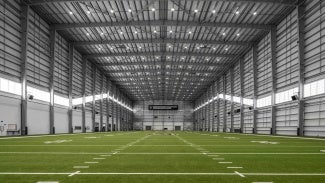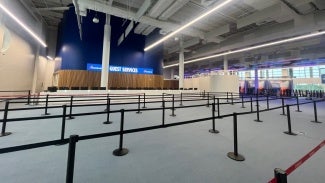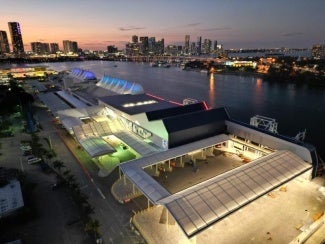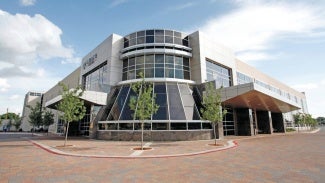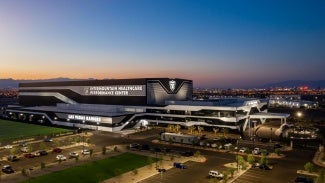
Design for the future: Flexibility for tomorrow’s needs
Three projects reveal the adaptability and versatility of pre-engineered metal buildings. AIA partner BlueScope Buildings North America gives a tour.
As building design adapts to meet shifting demands—driven by climate conditions, fluctuating business needs, and evolving regulatory standards—flexibility has become essential.
Designs that stand the test of time, structurally and aesthetically, require an eye beyond today into the future. Pre-engineered metal buildings (PEMBs) play an important role in this long-term design approach. These systems are well-suited for a variety of expansion, retrofit, and modular strategies, making them a smart fit for building teams that want to design for change without sacrificing quality or performance.
According to AIA’s Buildings That Last publication, “Design for adaptability happens at the beginning of the building’s lifespan; it means intentionally designing the building so that adapting it for future uses is not impossible or cost prohibitive.” PEMBs help project teams fulfill this intent by enabling forward-looking design strategies that perform from day one and evolve gracefully as needs change.
Las Vegas: Building at scale
When the NFL’s Raiders moved to Las Vegas, they needed a practice facility with enough panache and scale to fit one of the league’s signature franchises. The resulting structure needed to withstand the desert climate and the heavy athletic use of a pro football team, and it had to meet a strict height restriction because of its proximity to the city’s airport.
The solution? A custom-engineered indoor facility using a structural system with clear spans and a 100-foot clear height, making it the largest indoor football practice facility in the United States. To accomplish this feat, the project combined conventional framing with a pre-engineered roof system.
This structure meets the team’s functional requirements today while offering scalability for tomorrow. The building’s modularity and durability make future expansion or adaptation feasible, and the long-span framing eliminates interior columns, increasing long-term layout flexibility.
Miami: Flexible design through retrofitting
As demand for passenger capacity grew at the world’s busiest cruise port, Terminal F at PortMiami underwent expansion and redesign. Rather than demolishing and rebuilding, the design and construction team leveraged retrofit strategies to modernize and expand the terminal while preserving the existing structure.
The design incorporated several internal features, including new colors and textures, to go along with updated wayfinding in the new, larger space. Externally, one of the most defining expressions of the design comes from above. A PEMB roof system installed over the existing structure evokes the form and movement of ocean waves, creating a dynamic and meaningful architectural identity for the terminal.
A metal-over-metal retrofit system like PortMiami’s can extend the life of a building by decades, meet today’s most stringent energy codes, and achieve thermal insulation values up to a relatively high mark of R-38. The solution also avoided the need to remove the existing roof and did not disrupt operation below. The practical result was less waste, reduced project timelines, and significant energy improvements with minimal interference to daily operations. But beyond practical considerations, the design provides an evocative experience that will serve the building and its users for decades.
Lubbock, Tx.: Modular flexibility
When the owner of Grace Medical Clinic in Lubbock looked to the future, he saw a 110,000-square-foot structure with glass, natural light, and a focus on patient and practitioner well-being. But inside the multistory steel structure, a modular approach provided maximum flexibility that allowed the practice to create efficient and expandable spaces that kept patients on a clear path through their visit while allowing the medical team to work efficiently and out of view.
The complex’s modular design, combined with pre-engineered roofing systems, allows the clinic to alter spaces easily or expand quickly if the demand for services continues to grow. With this hybrid approach, aesthetic and practical designs work hand in hand to serve the community.
Why design for flexibility matters
Buildings are long-term assets. The ability to adapt, expand, and optimize over time adds value for both owners and communities. Pre-engineered systems such as those from Butler Manufacturing and Varco Pruden Buildings, when integrated thoughtfully into the architectural process, create the kind of future-focused spaces that evolve as needs shift.
Whether through scalable design, seamless retrofit, or rapid expansion, PEMBs offer a framework for enduring performance and a smarter way to build for the future.
Learn more by visiting BlueScope Buildings North America.
AIA does not sponsor or endorse any enterprise, whether public or private, operated for profit. Further, no AIA officer, director, committee member, or employee, or any of its component organizations in his or her official capacity, is permitted to approve, sponsor, endorse, or do anything that may be deemed or construed to be an approval, sponsorship, or endorsement of any material of construction or any method or manner of handling, using, distributing, or dealing in any material or product.

